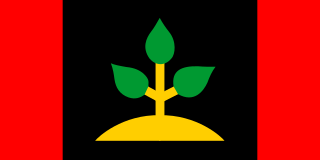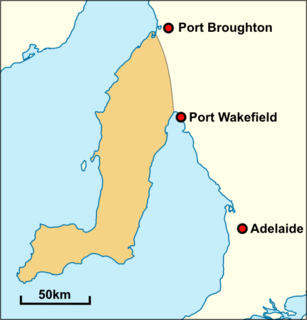The Bakanambia, also known as the Wanbara, are an Aboriginal group of Australia. Traditionally, the Bakanambia lived in the vicinity of Princess Charlotte Bay in the state of Queensland. One of the ethnonyms applied to them was Lama Lama, which is now used of a larger aggregation of remnants of several tribes.

The Larrakia people are a group of Aboriginal Australian people in and around Darwin in the Northern Territory. The Larrakia, who refer to themselves as "Saltwater People", had a vibrant traditional society based on a close relationship with the sea and trade with neighbouring groups such as the Tiwi, Wadjiginy and Djerimanga. These groups shared ceremonies and songlines, and intermarried.

The Narungga people, also spelt Narangga, are a group of Aboriginal Australians whose traditional lands are located throughout Yorke Peninsula, South Australia. Their traditional language, one of the Yura-Thura grouping, is Narungga.
The Ngurunta or Runda are believed to have been an indigenous Australian people of the state of South Australia located immediately west of Lake Frome.
The Amangu are an indigenous Yamatji people of the mid-western region of Western Australia.
The Kaneang are an indigenous Noongar people of the south west region of Western Australia.
The Jaako (Yaako) were an indigenous Australian people of the Northern Territory.
The Oitbi were an indigenous Australian people of the Cobourg Peninsula of the Northern Territory.
The Wurango or Wurrugu are an indigenous Australian people of the Northern Territory.
The Wakabunga are an indigenous Australian people of the state of Queensland.
The Nhanda people, also spelt Nanda, Nhunda, Nhanta, and other variants, are an Aboriginal Australian people who live in the mid-west region of Western Australia around the mouth of the Murchison River.
The Ngameni are an indigenous Australian people of South Australia who once spoke the Ngameni language.
The Wanggumara, also spelt Wangkumara, Wongkumara, Wangkumarra, and other variants, are an Aboriginal people of the state of Queensland, Australia.
The Maikulan were an indigenous Australian people of the state of Queensland. They have sometimes been confused with the Maithakari.
The Maikathari (Mayi-Thakurti) were an Aboriginal Australian people of the state of Queensland.
The Ringaringa (Ringu-Ringu) were an indigenous Australian people of the state of Queensland.
The Yilba, also written Ilba and Jilba, are or were an Aboriginal Australian people of the present-day state of Queensland.
The Mingin, also known as the Mingginda, are an Aboriginal Australian people of the state of Queensland, who lived in the Gulf Country east of Moonlight Creek and the Yukulta / Ganggalidda people in the southern Gulf of Carpentaria.
The Waluwara were an indigenous Australian people of the state of Queensland.
The Paaruntyi are an indigenous Australian people of the state of New South Wales. They are not to be confused with the Parrintyi.